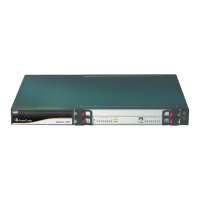User's Manual 272 Document #: LTRT-89730
Mediant 3000
• LDAP query is successful but call fails (due to, for example, busy line) to all the
relevant attribute destinations (private, Lync, PBX, and mobile), and a relevant
Tel-to-IP Release Reason (see Alternative Routing for Tel-to-IP Calls on page
513) or SBC Alternative Routing Reason (see Configuring SIP Response Codes
for Alternative Routing Reasons on page 614) has been configured.
Once the device receives the original incoming call, the first rule that it uses is Rule 6,
which queries the AD server. When the AD replies, the device searches the table, from the
first rule down, for the matching destination phone prefix (i.e., "PRIVATE:, "PBX:", "OCS:",
"MOBILE:", and "LDAP_ERR:"), and then sends the call to the appropriate destination.
16.3.12.3 Querying the AD for Calling Name
The device can retrieve the calling name (display name) from an LDAP-compliant server
(for example, Microsoft Active Directory / AD) for Tel-to-IP calls that are received without a
calling name.
The device uses the calling number (PBX or mobile number) for the LDAP query. Upon an
incoming INVITE, the device queries the AD based on the Calling Number search key (tries
to match the calling number with the appropriate "telephoneNumber" or "mobile" number
AD attribute entry). It then searches for the corresponding calling name attribute,
configured by the MSLDAPDisplayNameAttributeName parameter (e.g., “displayName”).
The device uses the resultant calling name as the display name parameter in the SIP From
header of the outgoing INVITE message.
To configure this feature, the following keywords are used in the Calling Name
Manipulation Table for Tel-to-IP Calls table for the 'Prefix/Suffix to Add' fields, which can be
combined with other characters:
"$LDAP-PBX": LDAP query using the MSLDAPPBXAttrName parameter as the search
key
"$LDAP-MOBILE": LDAP query using MSLDAPMobileAttrName parameter as the
search key
If the source (calling) number of the Tel-to-IP call matches the PBX / MOBILE (e.g.,
"telephoneNumber" and "mobile") number in the AD server, the device uses the resultant
Display Name instead of the keyword(s).
For example, assume the following configuration in the Calling Name Manipulation Table
for Tel-to-IP Calls:
'Source Prefix' field is set to "4".
'Prefix to Add' field is set to "$LDAP-PBX Office".
If the calling number is 4046 and the resultant LDAP query display name is "John Doe", the
device sends the INVITE message with the following From header:
From: John Doe <sip:4064@company.com>
Notes:
• The Calling Name Manipulation Table for Tel-to-IP Calls table uses the numbers
before manipulation, as inputs.
• The LDAP query uses the calling number after source number manipulation, as
the search key value.

